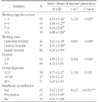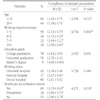Abstract
Objectives
The aim of this study was to examine the knowledge, safety climate, and compliance with hospital standard precautions among dental hygienists, and investigate the influencing factors.
Methods
A biased sampling method was used. Using the modified questionnaire, data were collected from 146 dental hygienists working at dental hospitals, general hospitals, and University hospitals, during September to October 2015. Data were entered and analyzed using software SPSS 20.0.
Results
The knowledge, safety climate, and compliance score of the hygienists regarding hospital standard precautions, were high when evaluation was carried out during healthcare accreditation or its preparation. The most important factor affecting compliance with the hospital standard precautions was working experience.
Figures and Tables
References
1. Ministry of Health and Welfare: Korea Hospital infection management guidelines. Seoul: Korea centers for disease control and prevention;2010.
2. Ahn YS, Lim HS. Occupational diseases among agricultural, forestry and fishery workers approved by korea labor welfare corporation. Korean J Occup Environ Med. 2007; 19:1–16.

3. Ju HJ, Lee JH. Structural relationship of variables regarding nurse's preventive action against needle stick injury. J Korean Acad Soc Nurs Educ. 2015; 21:168–181.

4. Horimoto T, Kawaoka Y. Pandemic threat posed by avian influenza A virus : A master of metamorphosis. Clin Microbiol Rev. 2001; 14:129–149.
5. Jeong SY, Oh HS, Chun HK. Analysis of the status of infection controls after application of the healthcare accreditation system. Korean J Health Serv Manag. 2015; 9:33–49.

6. Kang MW. Infection management in Korea and improvement plan. J Korean Hosp Assoc. 2003; 32:9–11.
7. Cho GL, Choi JS. Knowledge of and compliance with standard precautions by nurses in intensive care unit. J Korean Acad Fundam Nurs. 2010; 17:73–81.
8. Beltramni Em. Risk management of blood borne infections in HCW. Clin Microbiol Rev. 2000; 13:385–407.
9. Song YC, Kim SM, Um KH, Jang SI. A study on dental hospital staff's acceptance toward the dental institutions accreditation system -A study of infection management part. Korean J Hosp Manag. 2010; 15:123–142.
10. Suh YH, Oh HY. Knowledge, perception, safety climate, and compliance with hospital infection standard precautions among hospital nurses. J Korean Clin Nurs Res. 2010; 16:61–70.
11. Kim KM, Choi JS. Factors affecting core competencies among infection control nurses in Korea. Korean J Adult Nurs. 2014; 26:11–21.

12. Kang EJ, Choi HJ. A study on handwashing of health science students. J Korean Soc Dent Hyg. 2013; 13:449–556.
13. Kim HR, Park MR, Sung HJ, Jo CY, Ryu HG. Perception and implementation for dental infection control in Busan, Kyung Nam areas. J Korean Acad Dent Hyg. 2012; 14:11–12.
14. Kim JH, Lee KY. A study on the infection control attitude of dent hygienists. J Dent Hyg Sci. 2009; 9:129–136.
15. Park KY, Han DW. A comparison and analysis of the compliance, knowledge and safe environment of standard precautions for infection prevention among physical therapists in general hospitals and rehabilitation hospitals. J Korean Data Anal Soc. 2012; 14:271–281.
16. Jeong SY, Oh HS, Chun HK. Analysis of the status of infection controls after application of the healthcare accreditation system. Korean J Health Serv Manag. 2015; 9:33–49.

17. Nam MH, Kang SH. The cognition level on the patient safety and safe nursing activities among hospital nurses in Busan. Health Soc Sci. 2010; 28:197–221.
18. Yun JY, Kim SO, Kim IS. Influencing factors on practice of healthcare-associated infection control among clinical nurses. Korean J Occup Health Nurs. 2014; 23:208–218.

19. Choi EM, Noh HJ, Cung WG, Mun SJ. Influence of working environment on infection control activities in dental hygienists. J Korean Soc Dent Hyg. 2016; 16:313–319.

20. Yun KO. A study on practice of infection control index in dental office. J Health Info Stat. 2013; 38:23–35.




 PDF
PDF ePub
ePub Citation
Citation Print
Print








 XML Download
XML Download